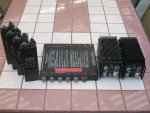902
Member
I think that if you removed the duplexers from the equation, setting up a low band repeater system wouldn't be a big deal if you could find a central transmitter site and several receiver sites which could be remoted with "poor man's microwave" (UHF links). I'm thinking you work on the NTIA side of the house, so maybe a few horizontally polarized A-band links bringing status tone and receive audio back to a voting comparator and a decent transmitter would be a very reliable wide-area system. And, for close-in, a receiver closer to the ground with adequate vertical and spectral separation without ever needing a duplexer. Those things are just unwieldy at 40 MHz - like stringing water heaters together. One police department near where I lived 25 years ago used duplexers on 39 MHz and it occupied much of their radio area.
Just after I moved and took a job in the Midwest, my employer (a consortium of public sector agencies) was embroiled in battle royale style politics with county government for who had control. As VHF high band was at a premium and was warehoused by a number of agencies who had a Monday channel, a Tuesday channel, a channel for this, a channel for that, etc. all on a first-come first-served basis, the only option I saw was low band. I had licensed a 33 MHz frequency for a repeater output and the next adjacent, 20 kHz away, for the input. There was also a 33 MHz fireground channel. I had sites, and I had surplus equipment (a Motrac Compa base). I put up a DB-201 at the transmit site, had a GE comparator, and a few voting receivers that I swapped boards to put on the 33 MHz input. They were fed into existing leased circuits we already had for another project. Faith and Begorrah, the thing worked marvelously. I had more than adequate isolation with 10 or so miles between transmit and receive sites, even at 20 kHz separation. I had a few Maxar 80 mobiles crystalled up for it, and it beat what we were using on high band at the time. As fate would have it, it never was put into play and was actually dismantled shortly before all of the consortium employees were laid off in the transition. Gotta love it. But as a proof of concept, it's certainly doable, and it could be done for very little. Granted, that was in 1997 when much of this stuff was still floating around. I haven't seen a low band Micor T81 chassis on the auction sites in ages, and don't particularly care for the lite duty stuff that's out there now.
My old 6 meter repeater was made out of some old PennDOT RCA 1000 radios that were modded to be in spec on 6. I may have one left that's on 52.525, but I'll be darned if I know where the cable, control head, and mic are for it anymore.
Just after I moved and took a job in the Midwest, my employer (a consortium of public sector agencies) was embroiled in battle royale style politics with county government for who had control. As VHF high band was at a premium and was warehoused by a number of agencies who had a Monday channel, a Tuesday channel, a channel for this, a channel for that, etc. all on a first-come first-served basis, the only option I saw was low band. I had licensed a 33 MHz frequency for a repeater output and the next adjacent, 20 kHz away, for the input. There was also a 33 MHz fireground channel. I had sites, and I had surplus equipment (a Motrac Compa base). I put up a DB-201 at the transmit site, had a GE comparator, and a few voting receivers that I swapped boards to put on the 33 MHz input. They were fed into existing leased circuits we already had for another project. Faith and Begorrah, the thing worked marvelously. I had more than adequate isolation with 10 or so miles between transmit and receive sites, even at 20 kHz separation. I had a few Maxar 80 mobiles crystalled up for it, and it beat what we were using on high band at the time. As fate would have it, it never was put into play and was actually dismantled shortly before all of the consortium employees were laid off in the transition. Gotta love it. But as a proof of concept, it's certainly doable, and it could be done for very little. Granted, that was in 1997 when much of this stuff was still floating around. I haven't seen a low band Micor T81 chassis on the auction sites in ages, and don't particularly care for the lite duty stuff that's out there now.
My old 6 meter repeater was made out of some old PennDOT RCA 1000 radios that were modded to be in spec on 6. I may have one left that's on 52.525, but I'll be darned if I know where the cable, control head, and mic are for it anymore.


